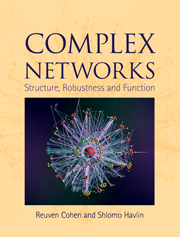Book contents
- Frontmatter
- Contents
- 1 Introduction
- PART I RANDOM NETWORK MODELS
- PART II STRUCTURE AND ROBUSTNESS OF COMPLEX NETWORKS
- 6 Distances in scale-free networks: the ultra small world
- 7 Self-similarity in complex networks
- 8 Distances in geographically embedded networks
- 9 The structure of networks: the generating function method
- 10 Percolation on complex networks
- 11 Structure of random directed networks: the bow tie
- 12 Introducing weights: bandwidth allocation and multimedia broadcasting
- PART III NETWORK FUNCTION: DYNAMICS AND APPLICATIONS
- Appendix A Probability theoretical methods
- Appendix B Asymptotics and orders of magnitude
- Appendix C Algorithms for network simulation and investigation
- References
- Index
11 - Structure of random directed networks: the bow tie
from PART II - STRUCTURE AND ROBUSTNESS OF COMPLEX NETWORKS
Published online by Cambridge University Press: 05 August 2013
- Frontmatter
- Contents
- 1 Introduction
- PART I RANDOM NETWORK MODELS
- PART II STRUCTURE AND ROBUSTNESS OF COMPLEX NETWORKS
- 6 Distances in scale-free networks: the ultra small world
- 7 Self-similarity in complex networks
- 8 Distances in geographically embedded networks
- 9 The structure of networks: the generating function method
- 10 Percolation on complex networks
- 11 Structure of random directed networks: the bow tie
- 12 Introducing weights: bandwidth allocation and multimedia broadcasting
- PART III NETWORK FUNCTION: DYNAMICS AND APPLICATIONS
- Appendix A Probability theoretical methods
- Appendix B Asymptotics and orders of magnitude
- Appendix C Algorithms for network simulation and investigation
- References
- Index
Summary
Many real complex networks have directed links, a property that affects the network's navigability and large-scale topology. Here we present the percolation properties of such directed scale-free networks with correlated in- and out-degree distributions [SCbA+02]. We derive a phase diagram that indicates the existence of three regimes, determined by the values of the degree exponents. In the first regime, we attain the known directed percolation mean-field exponents. In contrast, the second and third regimes are characterized by anomalous mean-field exponents that we calculate analytically. In the third regime the network is resilient to random dilution, i.e., the percolation threshold is pc → 0.
Introduction
Real networks are sometimes directed; for example, in social and economical networks, a node A gains information or acquires physical goods from node B, but node B does not necessarily get similar input from node A. Likewise, most metabolic reactions are one directional. Thus, changes in the concentration of molecule A affect the concentration of its product B, but the reverse is not true. Despite the directedness of many real networks, the modeling literature, with few notable exceptions [CRS+03, DMS01b, NSW01, SCbA+02], has focused mainly on undirected networks.
- Type
- Chapter
- Information
- Complex NetworksStructure, Robustness and Function, pp. 123 - 132Publisher: Cambridge University PressPrint publication year: 2010



